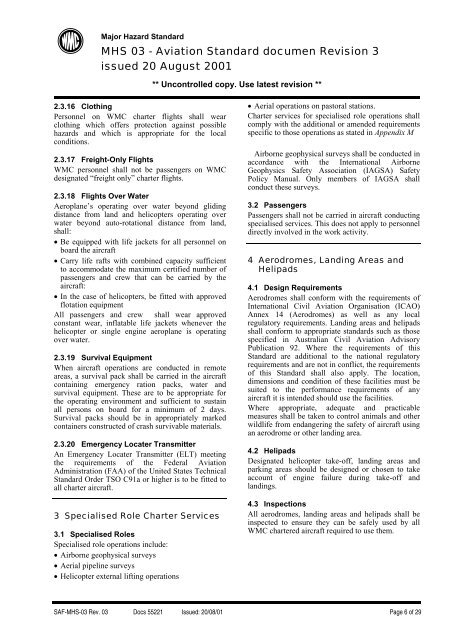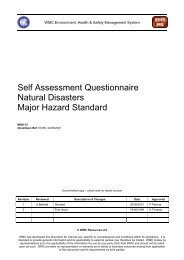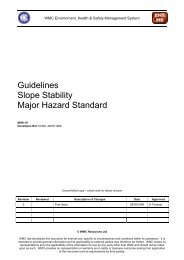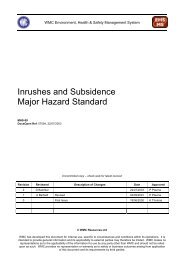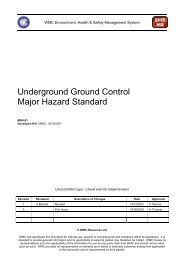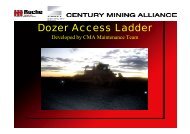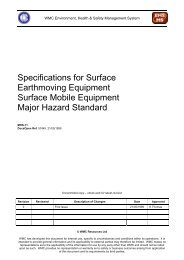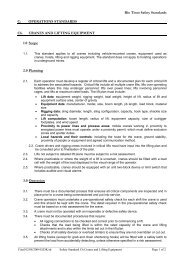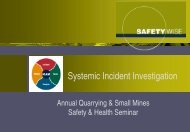Aviation Major Hazard Standard - MIRMgate
Aviation Major Hazard Standard - MIRMgate
Aviation Major Hazard Standard - MIRMgate
Create successful ePaper yourself
Turn your PDF publications into a flip-book with our unique Google optimized e-Paper software.
<strong>Major</strong> <strong>Hazard</strong> <strong>Standard</strong><br />
MHS 03 - <strong>Aviation</strong> <strong>Standard</strong> documen Revision 3<br />
issued 20 August 2001<br />
** Uncontrolled copy. Use latest revision **<br />
2.3.16 Clothing<br />
Personnel on WMC charter flights shall wear<br />
clothing which offers protection against possible<br />
hazards and which is appropriate for the local<br />
conditions.<br />
2.3.17 Freight-Only Flights<br />
WMC personnel shall not be passengers on WMC<br />
designated “freight only” charter flights.<br />
2.3.18 Flights Over Water<br />
Aeroplane’s operating over water beyond gliding<br />
distance from land and helicopters operating over<br />
water beyond auto-rotational distance from land,<br />
shall:<br />
• Be equipped with life jackets for all personnel on<br />
board the aircraft<br />
• Carry life rafts with combined capacity sufficient<br />
to accommodate the maximum certified number of<br />
passengers and crew that can be carried by the<br />
aircraft:<br />
• In the case of helicopters, be fitted with approved<br />
flotation equipment<br />
All passengers and crew shall wear approved<br />
constant wear, inflatable life jackets whenever the<br />
helicopter or single engine aeroplane is operating<br />
over water.<br />
2.3.19 Survival Equipment<br />
When aircraft operations are conducted in remote<br />
areas, a survival pack shall be carried in the aircraft<br />
containing emergency ration packs, water and<br />
survival equipment. These are to be appropriate for<br />
the operating environment and sufficient to sustain<br />
all persons on board for a minimum of 2 days.<br />
Survival packs should be in appropriately marked<br />
containers constructed of crash survivable materials.<br />
2.3.20 Emergency Locater Transmitter<br />
An Emergency Locater Transmitter (ELT) meeting<br />
the requirements of the Federal <strong>Aviation</strong><br />
Administration (FAA) of the United States Technical<br />
<strong>Standard</strong> Order TSO C91a or higher is to be fitted to<br />
all charter aircraft.<br />
3 Specialised Role Charter Services<br />
3.1 Specialised Roles<br />
Specialised role operations include:<br />
• Airborne geophysical surveys<br />
• Aerial pipeline surveys<br />
• Helicopter external lifting operations<br />
• Aerial operations on pastoral stations.<br />
Charter services for specialised role operations shall<br />
comply with the additional or amended requirements<br />
specific to those operations as stated in Appendix M<br />
Airborne geophysical surveys shall be conducted in<br />
accordance with the International Airborne<br />
Geophysics Safety Association (IAGSA) Safety<br />
Policy Manual. Only members of IAGSA shall<br />
conduct these surveys.<br />
3.2 Passengers<br />
Passengers shall not be carried in aircraft conducting<br />
specialised services. This does not apply to personnel<br />
directly involved in the work activity.<br />
4 Aerodromes, Landing Areas and<br />
Helipads<br />
4.1 Design Requirements<br />
Aerodromes shall conform with the requirements of<br />
International Civil <strong>Aviation</strong> Organisation (ICAO)<br />
Annex 14 (Aerodromes) as well as any local<br />
regulatory requirements. Landing areas and helipads<br />
shall conform to appropriate standards such as those<br />
specified in Australian Civil <strong>Aviation</strong> Advisory<br />
Publication 92. Where the requirements of this<br />
<strong>Standard</strong> are additional to the national regulatory<br />
requirements and are not in conflict, the requirements<br />
of this <strong>Standard</strong> shall also apply. The location,<br />
dimensions and condition of these facilities must be<br />
suited to the performance requirements of any<br />
aircraft it is intended should use the facilities.<br />
Where appropriate, adequate and practicable<br />
measures shall be taken to control animals and other<br />
wildlife from endangering the safety of aircraft using<br />
an aerodrome or other landing area.<br />
4.2 Helipads<br />
Designated helicopter take-off, landing areas and<br />
parking areas should be designed or chosen to take<br />
account of engine failure during take-off and<br />
landings.<br />
4.3 Inspections<br />
All aerodromes, landing areas and helipads shall be<br />
inspected to ensure they can be safely used by all<br />
WMC chartered aircraft required to use them.<br />
SAF-MHS-03 Rev. 03 Docs 55221 Issued: 20/08/01 Page 6 of 29


